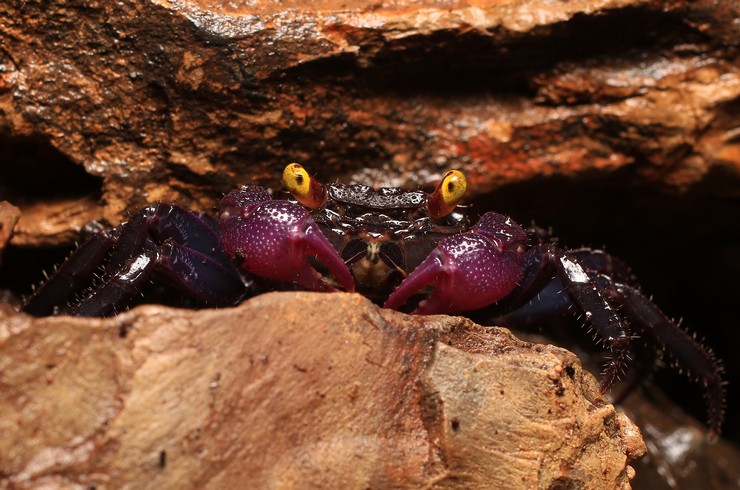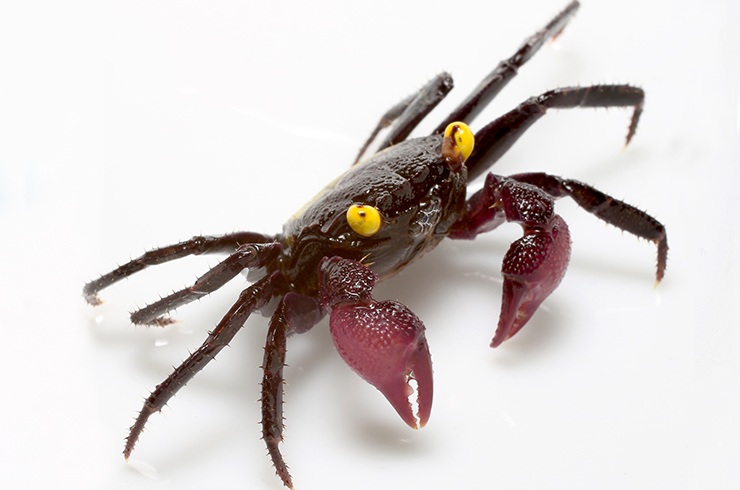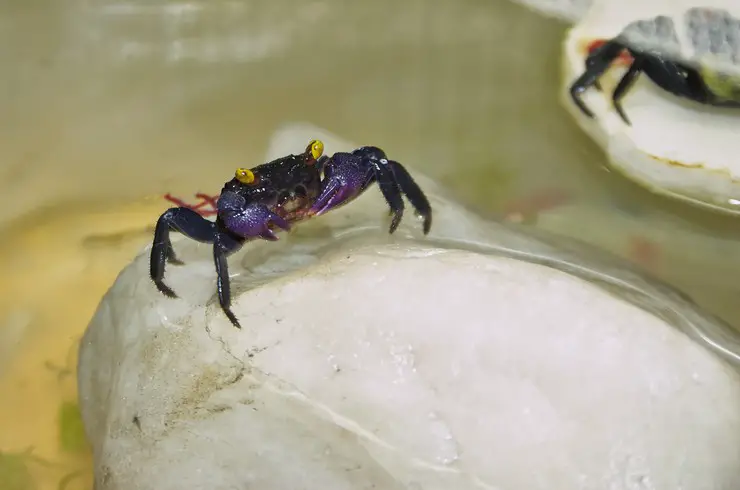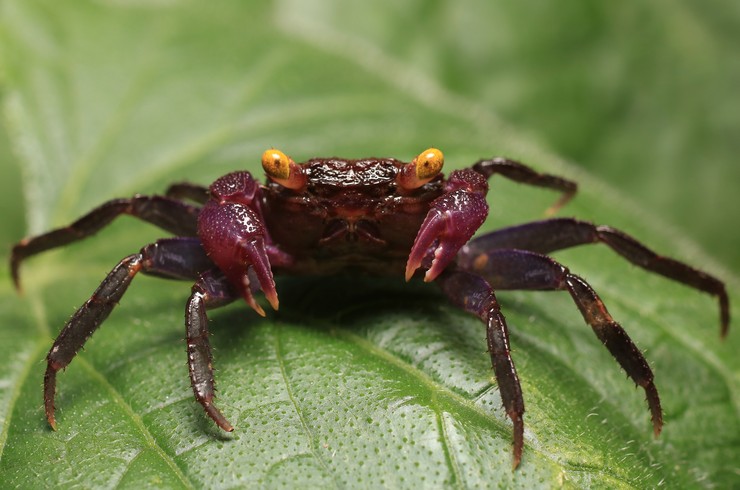Aquarium crabs have appeared in hobbyist aquariums quite recently, but every year these unusual pets attract more and more attention. Among these interesting animals, there are both rather large representatives and real dwarfs. The latter include crabs with the terrifying name “vampires”, which will be discussed in our article.
General information
Vampire crabs (Geosesarma dennerle) are freshwater tropical crabs with a predominantly terrestrial lifestyle. The specified species is the most common dwarf crab, however, all representatives of the genus are often called “vampires”. These crabs are distinguished by their miniature size and beautiful colors. The babies acquired their name not at all for bloodthirstiness, but because of their bright yellow eyes, which contrast strongly with the main body color.
Vampire crabs are still considered exotic, and it is not too easy to find them on sale, although they are perfectly bred at home. These crustaceans are one of the most interesting pets while being simple to keep.
A big plus that vampire crabs can be settled in groups. Observing the life of these crustaceans will give you a lot of fascinating moments. Crabs are able to recognize their master, they easily take food from his hands. Small skirmishes over food (not harmful) look very funny.
Unfortunately, in their natural habitats, vampire crabs are on the verge of extinction, which is associated with both capture for sale and the destruction of natural biotopes.
Appearance
The body of the vampire crab is round and covered with a strong chitinous shell – carapace. Its size does not exceed 3 cm. On the sides of the body, there are five pairs of walking legs, the front of which has been modified into claws. They serve as an organ of food capture and protection. The organs of vision rise above the front of the body – eyes on movable stalks, painted yellow or orange. Slightly below is the mouth opening with the jaws.
The color of the vampire crabs is deep purple, the claws are lighter than the rest of the limbs. There is a large spot on the carapace, which reminds many of the silhouettes of a bat. According to one theory, the species could also get its name from this spot.
Life expectancy is short, not exceeding 3 years.

Habitat
Representatives of the species live on the island of Java, preferring the banks of small streams where crabs dig their burrows.
Care and maintenance
Vampire crabs do not differ in whimsical content, but there are several important points to which it is desirable to pay close attention.
These crustaceans are not completely aquatic. For a comfortable existence, it is necessary to equip an aqua terrarium or paludarium with a volume of 20 liters or more, in which there will be two sections: water and land. Crabs molt in the water, and they can hide there. Its level should not exceed 15 cm. A filter is installed here to maintain the high quality and purity of water, as well as other additional equipment, for example, a fog generator. It is necessary to have a gentle slope so that the crabs can easily crawl onto land because they cannot stay in the water for a long time. Be sure to install a cover on the aqua terrarium, and cover all technological holes with something. Vampire crabs are famous for their extraordinary ability to escape, so it’s best not to let this happen.
The ground part consists of a mixture of peat, coconut substrate, and sphagnum moss. Crabs do not damage living plants, so the aqua terrarium can be decorated without fear with aquarium plants that can live in a paludarium – Anubias, Cryptocorynes, Bucephalandra, Echinodorus, etc.
Be sure to provide your crabs with a variety of hiding places, both in the water and on land. Grottoes, broken ceramic pots, driftwood will do.
In the aqua terrarium with vampire crabs, it is important to maintain a special microclimate. The water temperature should be 24-26 ° С, and the air temperature should be 25-28 ° С. High humidity is very important, it reaches 60-95%. To do this, the soil, decor, plants, and walls of the container must be sprayed with water from a spray bottle several times a day. You can also use a mist generator that produces water vapor from water using ultrasound. A special heating mat or cord can be placed under the aqua terrarium. This will speed up the evaporation of the water and lead to increased humidity. The water should have a reaction close to neutral (pH = 7.0-7.5) and be sufficiently hard (GH = 10-20).
An important stage in the life of every vampire crab is molting. The dense cover on the body does not allow it to grow, therefore, to increase in size, the crabs shed the old shell and acquire a new one, which will allow the animal to grow in size until it hardens. The younger the crab, the more often it sheds. The discarded cover should never be thrown out of the aquarium. Crabs themselves will eat it with great pleasure in order to replenish the reserves of calcium and other elements in the body.
An amazing fact: in the process of molting, vampire crabs restore lost limbs, so if for some reason your pet was left without a claw or leg, then you should not worry too much about this.
The water in the container with the vampire crabs must be changed weekly to avoid the accumulation of toxic metabolic products, along with this they also siphon the soil. Most often, water from the central water supply is used for replacements. Unfortunately, it can pose a threat to crabs, as it often contains chlorine compounds and heavy metals. Therefore, add the Tetra Crusta AquaSafe conditioner to the water when starting up the aqua terrarium and at every water change. It will help you avoid water settling by making it instantly safe and ready to use for a change. It also contains iodine and magnesium, which are necessary for the proper molting of crabs.
Compatibility
Considering that the vampire crab is mainly a land dweller and only needs a small amount of water, it is extremely difficult to recreate comfortable living conditions in the aqua terrarium, so it is best not to combine a group of vampire crabs with fish and other aquatic inhabitants.
Although by nature these animals are very calm and do not offend even small aquarium inhabitants: guppies, shrimps, ampulla.
Feeding the vampire crab
Vampire crabs are omnivores. The basis of their diet in nature is detritus – decaying residues of predominantly plant origin. This is a big plus in keeping these crustaceans because if necessary, you can leave them without additional feeding for several days.
It is advisable to use high-quality dry food for crustaceans from the Tetra Crusta series as a base feed. They are balanced, contain both animal and vegetable products, and a complex of vitamins to support health. Crabs also eat well with universal catfish tablets such as Tetra WaferMix.
The vegetable part of the vampire crab’s diet should consist of small pieces of vegetables and fruits: cucumber, tomato, banana, peach, etc. They also like to chew dried tree leaves – Indian almond leaves, which can be purchased at pet stores, or dried and scalded oak leaves are perfect.
It is enough to feed the crab 2-3 times a week. Do not give a large amount of high-protein animal feed, this can provoke molt, for which the animal is not yet ready.
It is necessary to feed the vampire crab on land, it is best to put the food in a separate bowl on the shore. Pieces of food can be sprinkled or dipped in calcium-rich vitamins such as Tetra ReptoCal.
Reproduction and breeding
At home, getting offspring from vampire crabs is very simple. Create comfortable conditions for them in the aqua terrarium, and the animals will do the rest themselves. First of all, you need to take care of the presence of straight individuals. Fortunately, it is extremely easy to distinguish between a male and a female – just turn them over on their back and look at the abdomen (abdomen). In males it is narrow, and in females it is wide.
Puberty in crustaceans occurs at the age of 6-8 months. From this moment, approximately every six months, the female is able to bear about 50 eggs, from which young individuals appear. Since vampire crabs lead a terrestrial lifestyle, they do not have a larval stage, all transformations take place in an egg, and an already fully formed animal with a body size of about 1 mm is born. The color of babies is initially gray, but after a few molts, it becomes as bright as in adults.

